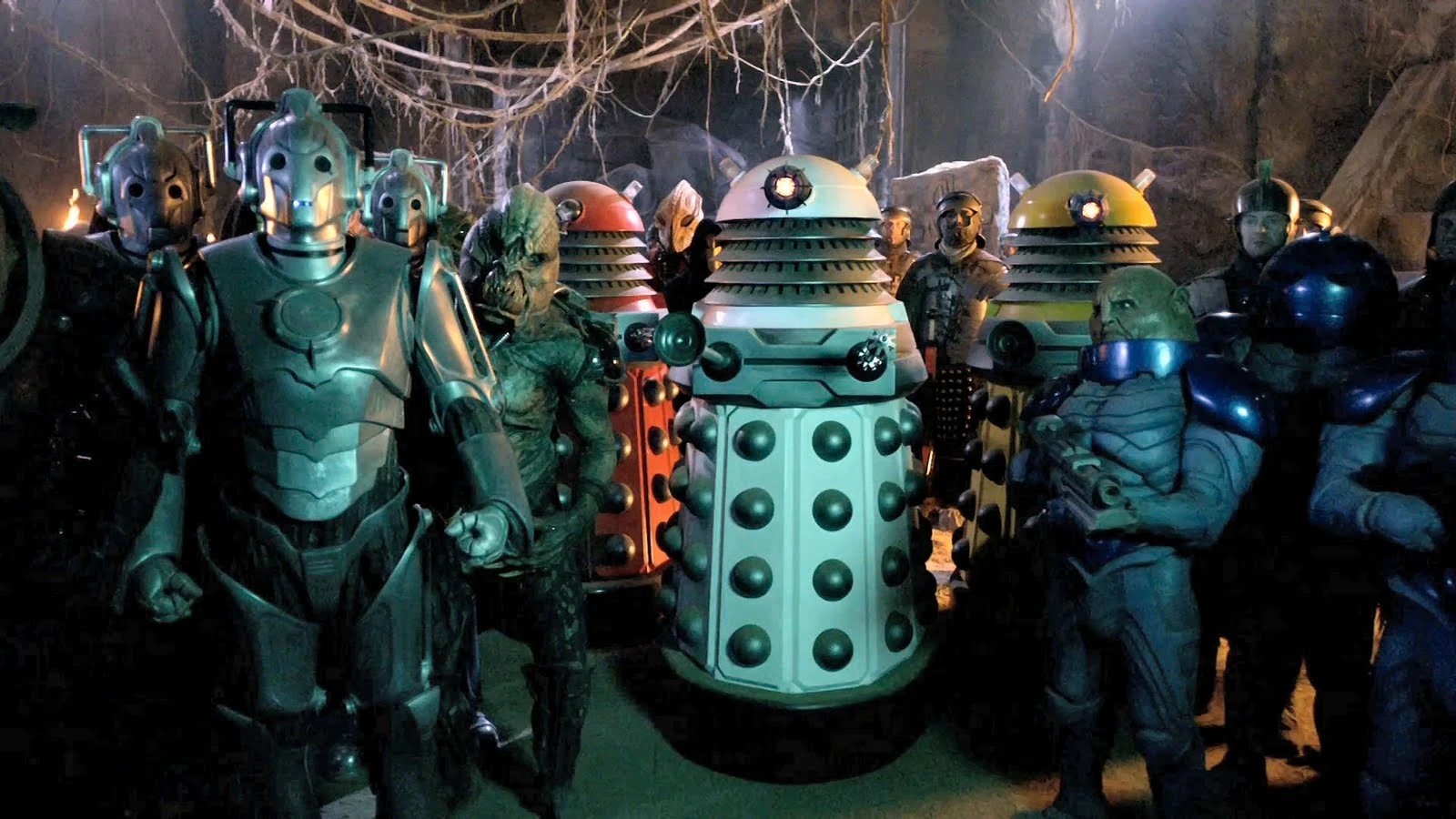There are some corners of the universe which have bred the most terrible things. But what is the key to making the perfect Doctor Who monster?

Over the last 60 years, writers have been tasked with coming up with a wide range of scary and unusual Doctor Who monsters to keep people hiding behind the sofa. Initially, the BBC said there should be no “bug-eyed monsters” in the series, and that it should focus on history, education and adventure. But the success of the Daleks in 1963 made them change their minds.
Arguably, much of the success of these Doctor Who monsters is the fact that they don’t look like a ‘men in suits.’ And this was their creator Terry Nation’s intention.
Here’s how he described them in his original script for ‘The Survivors’: “Hideous machine-like creatures, they are legless, moving on a round base. They have no human features. A lens on a flexible shaft acts as an eye. Arms with mechanical grips for hands.”

Nation had also been inspired by a recent performance of the Georgian State Dancers, where the actors had performed with such long skirts that they appeared to be gliding across the stage. He told the Daleks’ designer Raymond Cusick that this was how he envisaged his creations moving.
And whilst the popularity of these Doctor Who monsters was instant, it’s hard to pin down why the creatures resonated so strongly with audiences. Certainly, they were (to some extent) a reflection of their time; the Daleks were reminiscent of the Nazis from the Second World War with their blinkered, incessant desire to “exterminate” every living thing that was different from them. But, undoubtedly, the fact that these Doctor Who monsters didn’t look like ‘men in suits’ must have been a factor in their popularity.
At the same time, there are other famous Doctor Who monsters such as the Cybermen who are very much the opposite. But then, they are supposed to humanoid in shape; these monsters were originally human beings and, over time, had their body parts replaced with cybernetic alternatives (or, at least, this was how they were originally presented in ‘The Tenth Planet.’)

But the Cybermen are similar to the Daleks in that they, too, are one-track minded. But in the Cybermens’ case, they want to make everyone “become like them” rather than wipe them from the face of the earth. They are obsessed with the idea of turning everyone into Cybermen, or “upgrading them,” and they are uncompromising, emotionless, and completely lacking in humanity.
Certainly, it’s hard to say whether this blinkered, fascistic quality is key to their appeal, but their similarity with the Daleks cannot be overlooked.
Conversely, the Third Doctor Jon Pertwee famously stated that he found the Daleks rather boring and that, when it came to making an effective Doctor Who monster, he thought that “there’s nothing more alarming than coming home and finding a Yeti on your loo in Tooting Bec.” That is, it’s the collision with the known and the unknown that’s most frightening – the terrors of the wider universe finding their way into the comfort and familiarity of home.
And during the Jon Pertwee era, this idea became more prevalent as the Time Lord found himself exiled to Earth. So he battled many of his Doctor Who monsters on the streets of contemporary London, such as the shop window dummies in ‘Spearhead from Space’ or the dinosaurs in ‘Invasion of the Dinosaurs.’ Indeed, the idea that everyday objects or places could suddenly turn be deadly is one that has remained with the series ever since, with killer television sets in ‘The Idiot’s Lantern’ and evil scarecrows in ‘Human Nature.’
One common idea in New Who, though, is that of the unseen Doctor Who monster. The most notable example is Steven Moffat’s Weeping Angels who first appeared in the 2007 episode ‘Blink.’ And whilst they can technically be seen, they instantly turn into statues, and cover their eyes as if weeping; these monsters only move when out of sight, or when a person blinks – and if they get close enough, they feast on the victim’s unlived days and send them back into history.

The Weeping Angels were an instant hit when they made their debut in Doctor Who Series Three, and their enduring popularity is all-the-more incredible when one remembers that they don’t even speak (for the most part.)
Simplicity, then, is another important factor when creating the ‘perfect’ Doctor Who monster. And this is something that Steven Moffat had a real strength for, as seen in the 2014 episode ‘Listen’ where the monster is never actually shown. The idea is that the creature has perfected the art of perfect hiding and can therefore never be seen, but it is believed to linger under people’s beds and attack them when they wake.
But in a clever twist (spoiler alert) Steven Moffat drops a bombshell at the end of ‘Listen,’ hinting that this Doctor Who monster may never have existed in the first place. Clara suggests that the Doctor was imagining it all along, haunted by a frightening childhood memory that had left him paranoid.
However, the same cannot be said for another of New Who’s unseen Doctor Who monsters – the creature from the diamond planet of Midnight that launched an attack on the Crusader 50 bus. This monster almost certainly existed, but was never seen by the Doctor or his companions; it simply possessed its victims, communicating by repeating the words of others. It simply possessed its victims, communicating by repeating the words of others.
Again, the idea was simple, but effective. This Doctor Who monster didn’t depend on crafty CGI or impressive prosthetics but, like the Weeping Angels and the (possible) monster from ‘Listen,’ played on the horror of the unseen and the unknown, using fear itself as its deadliest weapon.
It would be a shame, though, if all Doctor Who monsters followed this pattern. Seeing a swathes of Sea Devils coming out of the sea or a platoon of Judoon upon the Moon is a huge part of Doctor Who‘s appeal and key to the Time Lord’s battle against evil. After all, he can’t really fight the monsters if he can’t see them!

And whilst it’s always a plus if a Doctor Who monster doesn’t look like a ‘man in a suit’ (a la Dalek), there have been a number of successful humanoid costumes over the years, such as the aforementioned Cybermen, or even Jon Pertwee’s favourite monster the Draconians, who first appeared in ‘Frontier in Space’ (although their status as a legitimate ‘baddie’ is debatable…)
What do you think is the ‘secret sauce’ for making a Doctor Who monster? And which villain is your all-time favourite? Let me know in the comments below.








Leave a Reply